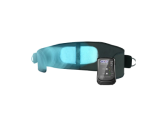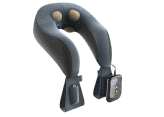What is Lateral Knee Pain?
“Lateral” knee pain describes pain that’s experienced on the outside of the knee, specifically on the right and left sides of the knee cap. Similarly, other variations of knee pain can also be described this way; the front of the knee is the anterior, the back, posterior, and the inside, medial. Identifying what kind of knee pain you have can help you get a better idea of the cause of your pain, allowing you to treat it properly.
That being said, let’s outline some of the most common causes of lateral knee pain in particular. Having the right knowledge under your belt can be the first step in your journey towards living a life with less knee pain.

Where is my knee pain coming from? Common Causes of Lateral Knee Pain
- Iliotibial band syndrome: The iliotibial band is important in stabilizing the lateral part of the knee as it flexes and straightens. It’s made up of connective tissues that come from the outer hip, down to the shinbone. Pain here can come from overuse and repeated motions, making athletic people more prone to developing ITBS.
- Lateral meniscus tear: Injury to the lateral part of the knee can result in a meniscus tear. Menisci are two pieces of cartilage that sit in between femur and tibia bones. Sudden twisting motions often performed by athletes can cause a tear. The deterioration of this cartilage can also happen with age, making it more difficult to straighten the knee over time.
- Arthritis: Though there are many different types of arthritis that can affect the knee, the most common is known as Osteoarthritis. Osteoarthritis is a degenerative joint disease where cartilage breaks down over time, causing the bones in the knee joint to rub together. This can cause significant pain and swelling all over the knee, including in the lateral parts.
- Other injuries: Ligament sprains, fractures, contusions (bruises) and more can cause lateral knee pain. Those who are very physically active are more vulnerable to injuring the lateral part of the knee.

People of all ages can experience knee pain due to a variety of causes. Although everyone experiences it differently, it’s undeniable that knee pain can be intrusive in your daily life, goals, overall lifestyle and outlook — knee pain is more than just a physical ailment. And you’re not alone in your experience either — about 1 in 4 adults struggle with knee pain.
What Can I Do About My Knee Pain?
You don’t have to simply accept your knee pain as it is, especially when it affects your quality of life and overall well-being. While there may not be a “cure” out there, there are certainly ways that you can effectively manage your knee pain from home.
Medications and procedures can be beneficial for the treatment of pain, but they aren’t a one-size-fits-all solution. Alternative methods of finding pain relief can be just as meaningful in your pain management routine. Overall, there is light at the end of the tunnel for pain sufferers.
Three Pain Management Methods for Lateral Knee Pain
Keep reading to discover three natural, drug-free pain management methods that knee pain sufferers can include in their routines to help keep pain at bay.
1. Hot & Cold Therapies for Knee Pain
Both hot and cold therapies can be beneficial for pain in the knee, depending on the source of your discomfort:
Cold therapy works by reducing blood flow to the knee and reducing nerve activity, helping to numb the sensations of pain. Apply something cold in the form of a cream, pad or ice pack to target swelling, inflammation and sharp pain. This form of therapy may be best for:
- Arthritis
- New injuries including meniscus tears, fractures or contusions

Heat therapy can improve local circulation, promote tissue healing and improve muscle flexibility. Apply something warm to the knee in the form of a cream or hot towel, or visit a sauna or hot tub for an experience that’s both relieving and relaxing. This form of therapy may be best for:
- Athletes
- Muscle recovery after strenuous activity
To ensure safety, never apply ice or burning temperatures directly on the skin. Once you are comfortable with the temperature, apply it to the pain-affected area for no more than 20-minutes at a time.
2. TENS Therapy for Lateral Knee Pain
TENS (Transcutaneous Electrical Nerve Stimulation) can offer knee pain sufferers a meaningful method of pain management that works to target pain directly through stimulation.
Here’s how it works: TENS is a versatile, natural pain therapy that is found in DR-HO’S devices like the Pain Therapy System 4-Pad. It works to deliver gentle electric currents through the nervous system via pads that can be placed anywhere on the body to temporarily stop pain signals from reaching the brain.

TENS works in conjunction with EMS (Electrical Muscle Stimulation) to target the muscles as well as the nerves. EMS stimulates muscles by contracting and releasing them wherever body pads are placed to soothe soreness and improve circulation. Better circulation in the muscles can help address stiffness and facilitate recovery.
TENS & EMS can offer lateral knee pain sufferers a meaningful addition to their pain management routine with effective, temporary pain relief that they can count on every time.
Interested in TENS Therapy for knee pain? Learn more here:
3. Stretches for Lateral Knee Pain
When you’re dealing with new-onset pain or a flare-up, you may be off your feet for a while. When you’re ready to get back up and at it, it’s important to ease yourself into being active again. Plus, overuse or sudden movements could have been the cause of your lateral knee pain in the first place.
To safely get back on your feet and prevent further pain, learn how to stretch properly before movement with these 3 stretches that target the knees, hips and hamstrings:

I. Heel Slide
Step 1: Lie on your back with your knees bent.
Step 2: Slide your heel back by bending your pain-affected knee as far as you can.
Step 3: Hook your other foot around your ankle to help pull your heel even further back.
Step 4: Hold for about 6 seconds, then rest for up to 10 seconds. Repeat this exercise around 10 times.
Step 1: Lunge forward with your right foot in front and your left knee on the floor, directly under your hips.
Step 2: Lift your left arm and stretch it over your head towards the right. Keep your hips square and don’t allow them to stretch forward. You’ll feel the stretch in the outer left hip.
Step 3: Hold this stretch and repeat on both sides.
Step 1: Stand on one foot with your other foot straightened, heel down and toes up.
Step 2: Hinge forward at the hips and bend the knee you’re standing on slightly.
Step 3: Feel the stretch in the hamstring of the straightened leg. Hold this pose for 30-60 seconds and repeat on the other side.

Understanding your knee pain can help you on your journey towards relief!
We hope that this guide to lateral knee pain helps you understand your pain better, and start feeling more like yourself sooner. Use our practical tips in your daily routine to keep pain at bay so you can get moving and do the things you love again!







